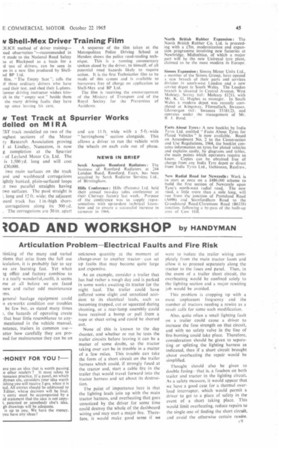tOAD AND WORKSHOP by HANDYMAN
Page 47

If you've noticed an error in this article please click here to report it so we can fix it.
Articulation Problem—Electrical Faults and Fire Risk
[linking of the many and varied 3Iems that arise from the full use ieulation, it is probably fair to say we are learning fast. Yet when lg office and factory combine to s a really wontlerful,outfit, it seems me at all before we are faced new and rather odd maintenance ans.
general haulage equipment could n ex-works condition our troubles be few but, as stated many times the hazards of operating create that bear little resemblance to anymentioned in the vehicle manual. nstance, trailers in common useatter how carefully they are proned for maintenance they can be an unknown quantity at the moment of change-over to another tractor can set up faults that may become quite large and expensive.
As art example, consider a trailer that has had rather a rough day and is parked in some works awaiting its tractor for the night haul. The trailer could have suffered some slight and unnoticed accident to its electrical leads, such as becoming trapped, cut or squeezed during shunting, or a rear-lamp assembly could have received a bump or pull from a rope or sheet string and could be shorted out.
None of this is known to the day shunter, and whether or not he tests the trailer circuits before leaving it can be a matter of some doubt, so the tractor raking over can be in trouble in a matter of a •few miles. This trouble can take the form of a short circuit on the trailer harness which could, if strongly fused at the tractor end, start a cable fire in the trailer that would travel forward into the tractor harness and set about its destruction.
The point of importance here is that the lighting leads join up with the main tractor harness, and overheating that goes unnoticed by the driver for some time could destroy the whole of the dashboard wiring and may start a major fire. Therefore, it would make good sense if We were to isolate the trailer wiring completely from the main tractor loom and allow it to proceed separately along the tractor to the fuses and panel. Then, in the event of a trailer short circuit, the overheating would be confined solely to the lighting section and a major rewiring job would be avoided.
This problem is cropping up with a most unpleasant frequency and the number of tractors needing a rewire as a result calls for some such modification.
Also, quite often a small lighting fault on a trailer could cause a driver to increase the fuse strength on that circuit, and with no safety valve in the line of fire burning could take place. Therefore, consideration should be given to separating or splitting the lighting harness as indicated, then if a short circuit brought about overheating the repair would be simplified.
thought should also be given to double fusingthat is, a fusebox on both trailer and tractor in the lighting circuit. As a safety measure, it would appear that we have a good case for a thermal overload interrupter, which would permit a driver to get to a place of safety in the event of a short taking place. This would limit overheating, reduce repairs to the single one of finding the short circuit, and avoid the otherwise certain rewire.
















































































































